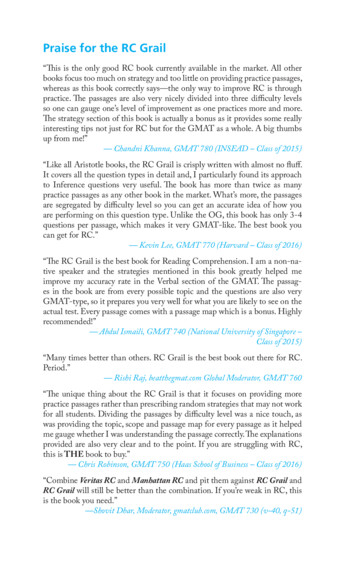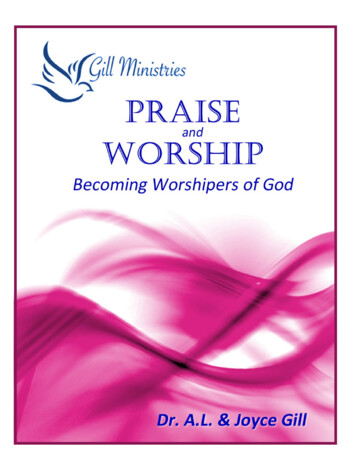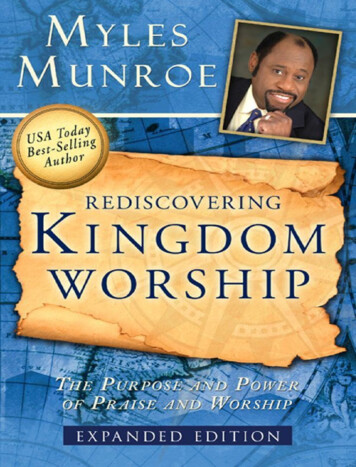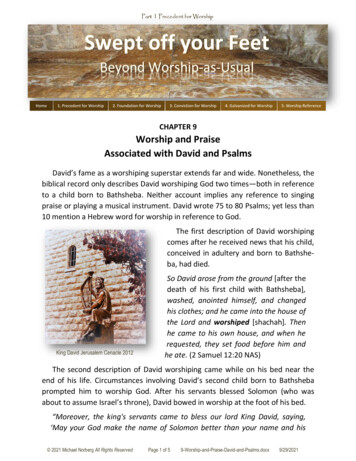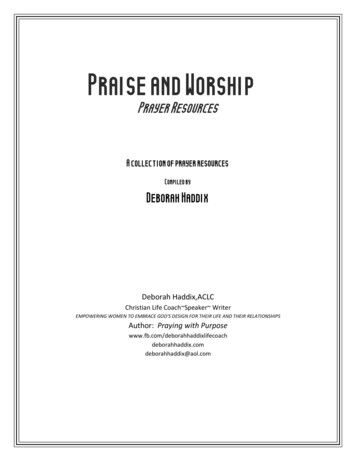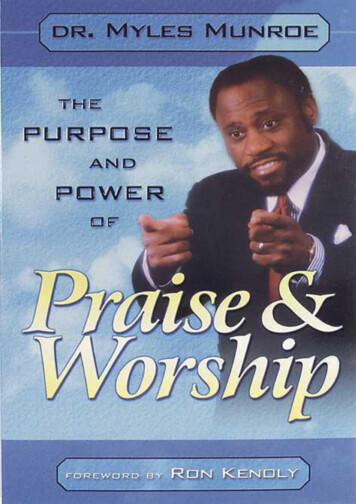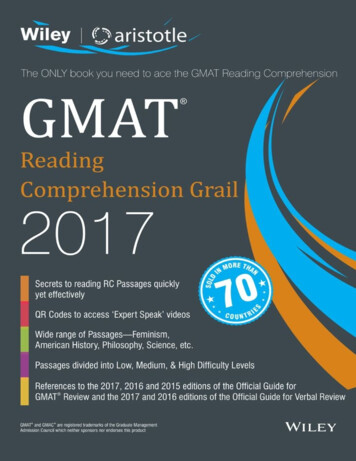
Transcription
Praise for the RC Grail“This is the only good RC book currently available in the market. All otherbooks focus too much on strategy and too little on providing practice passages,whereas as this book correctly says—the only way to improve RC is throughpractice. The passages are also very nicely divided into three difficulty levels soone can gauge one’s level of improvement as one practices more and more. Thestrategy section of this book is actually a bonus as it provides some reallyinteresting tips not just for RC but for the GMAT as a whole. A big thumbs upfrom me!”— Chandni Khanna, GMAT 780 (INSEAD – Class of 2015)“Like all Aristotle books, the RC Grail is crisply written with almost no fluff. Itcovers all the question types in detail and, I particularly found its approach toInference questions very useful. The book has more than twice as many practicepassages as any other book in the market. What’s more, the passages aresegregated by difficulty level so you can get an accurate idea of how you areperforming on this question type. Unlike the OG, this book has only 3-4questions per passage, which makes it very GMAT-like. The best book you canget for RC.”— Kevin Lee, GMAT 770 (Harvard – Class of 2016)“The RC Grail is the best book for Reading Comprehension. I am a non-nativespeaker and the strategies mentioned in this book greatly helped me improve myaccuracy rate in the Verbal section of the GMAT. The passages in the book arefrom every possible topic and the questions are also very GMAT-type, so itprepares you very well for what you are likely to see on the actual test. Everypassage comes with a passage map which is a bonus. Highly recommended!”— Abdul Ismaili, GMAT 740 (National University of Singapore – Class of 2015)“Many times better than others. RC Grail is the best book out there for RC.Period.”
— Rishi Raj, beatthegmat.com Global Moderator, GMAT 760“The unique thing about the RC Grail is that it focuses on providing morepractice passages rather than prescribing random strategies that may not workfor all students. Dividing the passages by difficulty level was a nice touch, aswas providing the topic, scope and passage map for every passage as it helpedme gauge whether I was understanding the passage correctly. The explanationsprovided are also very clear and to the point. If you are struggling with RC, thisis THE book to buy.”— Chris Robinson, GMAT 750 (Haas School of Business – Class of 2016)“Combine Veritas RC and Manhattan RC and pit them against RC Grail andRC Grail will still be better than the combination. If you’re weak in RC, this isthe book you need.”—Shovit Dhar, Moderator, gmatclub.com, GMAT 730 (v-40, q-51)
GMAT Reading Comprehension Grail 2017Copyright 2016 by Wiley. All rights reserved.Published by Wiley India Pvt. Ltd., 4435-36/7, Ansari Road, Daryaganj, New Delhi - 110002.No part of this publication may be reproduced, stored in a retrieval system or transmitted in any form or byany means, electronic, mechanical, photocopying, recording, scanning or otherwise, except as permittedunder Sections 107 or 108 of the 1976 United States Copyright Act, without either the prior writtenpermission of the Publisher, or authorization through payment of the appropriate per-copy fee to theCopyright Clearance Center, 222 Rosewood Drive, Danvers, MA 01923, (978) 750-8400, fax (978) 6468600, or on the web at www.copyright.com. Requests to the Publisher for permission should be addressedto the Permissions Department, John Wiley & Sons, Inc., 111 River Street, Hoboken, NJ 07030, (201) 7486011, fax (201) 748-6008, or online at http://www.wiley.com/go/permissions.The publisher and the author make no representations or warranties with respect to the accuracy orcompleteness of the contents of this work and specifically disclaim all warranties, including withoutlimitation warranties of fitness for a particular purpose. No warranty may be created or extended by sales orpromotional materials. The advice and strategies contained herein may not be suitable for every situation.This work is sold with the understanding that the publisher is not engaged in rendering legal, accounting, orother professional services. If professional assistance is required, the services of a competent professionalperson should be sought. Neither the publisher nor the author shall be liable for damages arising here from.The fact that an organization or Website is referred to in this work as a citation and/or a potential source offurther information does not mean that the author or the publisher endorses the information the organizationor Website may provide or recommendations it may make. Further, readers should be aware that InternetWebsites listed in this work may have changed or disappeared between when this work was written andwhen it is read.Trademarks: Wiley, the Wiley logo, and related trademarks are trademarks or registered trademarks ofJohn Wiley & Sons, Inc. and/or its affiliates. aristotle is a registered trademark of Aristotle Prep. TheGMAC and GMAT logos, GMAC , GMAT , Graduate Management Admission Council , and GraduateManagement Admission Test are registered trademarks of the Graduate Management AdmissionCouncil (GMAC) in the United States and other countries. All other trademarks are the property of theirrespective owners. John Wiley & Sons, Inc., is not associated with any product or vendor mentioned in thisbook.John Wiley & Sons, Inc., also publishes its books in a variety of electronic formats and by print-on-demand.Not all content that is available in standard print versions of this book may appear or be packaged in allbook formats. If you have purchased a version of this book that did not include media that is referenced byor accompanies a standard print version, you may request this media by visitinghttp://booksupport.wiley.com. For more information about Wiley products, visit us at www.wiley.com.ISBN 978-81-265-6260-210 9 8 7 6 5 4 3 2 1
ContentsIntroductionSection 1 – About the GMATSection 2 – Diagnostic TestSection 3 – Basics of Reading ComprehensionSection 4 – Reading Comprehension Question Types1. Global Questions2. Detail Questions3. Inference Questions4. Miscellaneous Questionsa. Function Questionsb.Vocabulary-in-Context Questionsc. Critical Reasoning type QuestionsSection 5 – Strategies to Tackle GMAT Reading ComprehensionSection 6 – Reading Comprehension Practice Passages1. Low Difficulty Passages2. Medium Difficulty Passages3. High Difficulty Passages4. Answers and ExplanationsSection 7 – Quick RecallIndex—QR Codes
IntroductionReading Comprehension (RC) is one of the problem areas for most studentsappearing for the GMAT. What makes RC especially difficult is that, unlike forSentence Correction, there are no specific rules that you can use to improve youraccuracy in Reading Comprehension overnight.It really helps if you have been in the habit of reading because then you alreadyhave a comfort level when it comes to reading and comprehending text; you arealso familiar with the various nuances of the English language and so you will bebetter able to identify the subtle hints provided by the author.However, most students are really not in the habit of reading. For such students,RC needs to be improved in the old fashioned way—with lots and lots ofpractice. While there are some basic strategies that will be discussed in thisbook, the stress will be on practicing as many passages as you can. For thisreason, we have provided 60 practice passages in this book so that you canperfect the strategies, detailed in the book, on these passages.Sections in this bookSection 1Gives you a broad overview of the GMAT—test format, duration, scoring, etc.Section 2Administers a diagnostic test that will hep you assess your level of competencein Reading Comprehension before you go through the concepts and strategies inthis book.Section 3Brings you up to speed with all the important concepts relevant to GMATReading Comprehension.Section 4Discusses the major question types tested on GMAT Reading Comprehensionand provides strategies on how to approach each of these.Section 5
Provides all the important strategies and tips necessary to effectively tackleGMAT Reading Comprehension.Section 6Contains a Reading Comprehension practice set with 60 passages dividedinto three difficulty levels—Easy, Medium, and High difficulty.Section 7Provides a Quick Recap of all the important concepts and rules covered in thisbook. This section saves you the trouble of taking notes so you can concentrateon understanding the concepts. Go through this section before every practice testthat you take.GMAT OG 2017, 2016 and 2015 and GMAT Verbal Review 2017and 2016 ReferencesFor most of the concepts and question types covered in this book, you will alsofind OG question references that will provide you with the question number ofsimilar questions present in the OGs 2015, 2016 and 2017 and also in the OGVerbal Review (VR) 2016 and 2017. As a result, you can see how the conceptsexplained in this book are actually tested on the GMAT.Access Videos Using QR CodesYou will see QR codes printed at different places in the book. By scanning theseQR codes using your smartphones, you will be able to access videos relevant tothe concept being discussed on that page. This will further help reinforce yourunderstanding of that comcept.Clearing your Doubts/QueriesThe purchase of this book provides you direct access to the experts who havewritten this book. So, in case there is any concept or question discussed in thisbook that you do not understand, please put up the same on the Forums sectionof our website: www.aristotleprep.com. Our experts will respond to you within48 hours and help clear all your doubts.To sum it up, we have tried to make the Aristotle Reading Comprehension Grail2017 as comprehensive and, at the same time, as student friendly as possible. We
are sure you will find this book useful in your prep.Good Luck & Study Hard!The Aristotle Prep Team
How to Access your VideosThis book contains ‘Expert Speak’ videos and other exclusive training contentthat you can easily access through an app—on your smartphone or tablet—usingthe QR codes provided at various places throughout the book.Step 1 – Download and Install the App on yourSmartphone/tabletTo access the videos and other content, you will need to download the ‘WileyTest Prep’ App from either Apple’s App store (iTunes) or Google play storeand install it on your Smartphone or tablet.For Apple devices:Go to iTunes and search for ‘Wiley Test Prep’ App. Locate the app from thedisplayed results and click on Install.For Android devices:Go to Google Play Store and search for ‘Wiley Test Prep’ App. Locate the appfrom the displayed results and click on Install.While installing the app, you will be asked to key in the unique registration codeprovided in a sealed envelope at the end of this book. This registration code willwork only once and on only one device.Step 2 – Scan the QR codes and access your training contentOnce you have installed the app, you can access the videos and training contenton your mobile device by scanning the QR codes provided throughout this book. Open the app and click on the ‘Scan QR Code’ menu option available underthe top right corner menu. This will start the scanning activity for thatparticular QR code. Focus the camera of your mobile device over the desired QR code given inthe book and wait for a few seconds till you hear the ‘tick’ sound. Oncethe QR code has been scanned and found valid, you will be directed tothe associated video/content.
Repeat the process for all other QR codes to access their associatedvideos/content.Note:1. The app login will be valid for 12 months from the date of activation.2. The app login is valid only for one device.3. In case of any difficulty, please reply to the confirmation email that youreceived in your inbox/junk email folder after registering on the app.
SECTION 1About the GMAT
What is the GMAT?The GMAT stands for Graduate Management Admission Test. It is an examrequired for admissions to MBA programs in the US and in other top businessschools across the world. It is also required for admission to a few Masters andPhD courses.It is very important for you to know that the GMAT is a computer adaptive test.This means that the difficulty level of the next question in a section isdetermined by your performance on the previous questions. Therefore, as youprogress through the test, the software continuously tries to evaluate yourperformance and adapts the difficulty level of the next questions to yourperformance on the previous ones. For this reason, you cannot skip or go back toquestions on the test.What does the GMAT consist of?The GMAT consists of four sections, which appear in the fixed order givenbelow.SectionTimeAnalysis of an Argument Essay30 minutesIntegrated Reasoning30 minutesQuantitative75 minutesVerbal75 minutesYou will get 12 questions in the Integrated Reasoning section, 37 questions inthe Quantitative section and 41 questions in the Verbal section.There are two optional 8-minute breaks during the GMAT. The first one is afterthe Integrated Reasoning section and the second one is after the Quantitativesection.
Integrated Reasoning questions can be further divided into thefollowing four question types: Graphics Interpretation Two-Part analysis Table Analysis Multi-Source ReasoningQuantitative questions can be further divided into the followingtwo question types: Problem Solving Data SufficiencyVerbal questions can be further divided into the following threequestion types: Sentence Correction Critical Reasoning Reading ComprehensionHow am I scored on the GMAT?The GMAT scores range from 200-800. A score of 200 is the lowest you can getand a score of 800 is the highest. For each section, you get something called ascaled score and there is also a percentile score corresponding to a scaled score. AWA – This section is scored on a scale of 0-6 in half-point increments. Integrated Reasoning – This section is scored on a scale of 0-8 in one-pointincrements Quantitative and Verbal – These two sections are scored on a scale of 51.The GMAC does not reveal how exactly this score is calculated, but we doknow for sure that the difficulty level of the questions you getcorrect/incorrect plays a big role in determining your final score on the test.
When can I take the GMAT? How many times is itconducted in a year?The GMAT can be taken at any time of the year. You sign up to take the examINDIVIDUALLY, whenever you are free. Yes, that’s right. The only thing toconsider is whether the date, on which you want to take the exam, is available atthe test centre of your choice. This is important in cities such as New York, LosAngeles, Beijing, New Delhi, etc., where the number of test takers is quite highand you may have to book a slot usually a month or two before your exam date.How do I register for the GMAT and how much is theexam fee?You can register for the GMAT by logging on to http://www.mba.com/ andthen going to the registration page. The GMAT exam fee is 250, as of 2016.What should I do after taking my GMAT?If your actual GMAT score is lower than what you would like it to be, you canalways retake the test. However, if you feel you have got a satisfactory score, itis time to start working on your business school applications. You will need tostart off by shortlisting schools based on criteria such as your desired field ofstudy, your GMAT score, the country or region you want to be in, etc. AtAristotle Prep, we have a full-fledged counselling division that can assist youwith the business school application process. You can go through our website fordetails.How do I prepare for the GMAT?As with any other test, you start off by going through the basic quant and verbalconcepts that are tested on the GMAT. Books such as the one you are holding inyour hands right now are one of the best ways of doing so.Once you have completed your basics, it’s time to apply all that learning onactual GMAT questions. At this point, you will want to get your hands on theThe Official Guide for GMAT Review (OG) set of books as these are the onlysource of actual GMAT questions.
Once you have completed all the questions in the OG, you need to start taking afew timed online practice tests. The GMAC provides you two of these tests(called the GMATPrep) for free on the official GMAT website: www.mba.com.You can access two more of these tests by purchasing them separately.Once you start scoring within 20-30 points of your desired score in theGMATPrep tests, it is time for you to book your test date and take the realGMAT.While you need to work hard to get a good GMATscore, you also need to work smart. The following aresome test-taking strategies for the smart test taker:Always try to narrow down your choices to two options.On a lot of questions, especially the high difficulty ones, you will often end upeliminating wrong answer choices rather than selecting the correct one. There isnothing wrong with this approach. In fact, we encourage students to start byeliminating wrong answer choices. The first time you read through the options,try to eliminate two or three that make absolutely no sense to you or that you arecertain are wrong. This shouldn’t be very difficult because it is not very easy forthe test makers to provide you with four or five equally confusing choices.So, the first time you go through the options, try to come down to two possibleanswers. Once you do this, you have increased your chances of getting theanswer correct from 20% to 50%, which are very good odds. Once you havenarrowed down to two possibilities, go through each of these options and try toidentify the one that better answers the question asked. It might also be a goodidea to re-read the question once again at this stage, as students often tend tomisread questions on the test.Time management will be the most important factor on the day ofthe test.A good way of pacing yourself on the GMAT is to follow what we, at Aristotle,call the 8/15 rule—for every 8 questions, you should take around 15 minutes,irrespective of the question-type mix. So, look at your watch after the first 15
minutes on the test—if you have completed more than 8 questions, then you aregoing too fast and probably need to slow down.Similarly if you have completed fewer than 8 questions, you are going too slowand need to pick up your pace. Depending on how far behind you are on yourtiming, guess on 1 or 2 questions in the next lot of 8 questions to catch up on thetime. Do not leave this guesswork for the end, as most students do, because thiscan have disastrous consequences on your overall score.The strategy of leaving the guesswork till the end will put too much pressure onyou towards the end of the test. You will invariably end up with a situation inwhich you have 6-7 questions left with 7-8 minutes to go, that is, a minute foreach question. Given that there will most likely be an RC passage amongst theselast questions, there is no way you can complete these questions in the remainingtime.What will eventually happen is that you will end up guessing on most or all ofthese questions. The problem with guessing is that, unless you are makingintelligent guesses (which will not be the case at the end of the test with youunder intense pressure), you can easily get most or even all of these questionswrong. If you get so many questions wrong in a row, your score will falldrastically. So, all your good work in the rest of the test could be undone by thislack of attention to pacing yourself on the test.How to guess intelligently?If you follow the 8/15 rule, you should not have to guess on too many questionsat the end of the test. However, in case you still end up having to guess on thelast 5-6 questions, here is an intelligent way of doing so that will ensure thatyour score does not fall by too much.Let’s start by assuming that you are on Question number 36 in the section (thatis, you have 5-6 questions remaining), and your current scaled score is 34 (ofcourse you’ll have no way of knowing this but let’s just assume this to be thecase). Now, assuming that you have six minutes remaining on the test, howwould you approach these last six questions?Most of you would immediately see that you have one minute left for eachquestion, so you would spend that minute on each question and if you could notarrive at the answer in a minute you would guess something and move to thenext question.
By following this approach, there is a very high possibility that you will get allor most of these questions wrong, since it’ll be very difficult to attempt questionsin a minute at the end of the test, especially CR and RC ones. Yourconcentration levels will be very low and stress levels very high, which meansyou will need to read the question two or three times just to understand what it isstating.The problem is that by this time your one minute will already be up, so you willend up making a random guess and moving on. If you get most of these lastquestions wrong, your score will fall from 34 to somewhere around 27-28.Remember, your score falls drastically if you get several questions incorrect in arow.Here is a smarter way of approaching the same situation, that is, six questions tobe attempted in six minutes with your scaled score on 34—guess quickly onquestion 36, and by quickly we mean take five seconds at most, so mark anyrandom option and move. Now for question 37, take two minutes and try to get itright.Since you’ve most probably got the last question wrong, this should in any casenot be a very high difficulty question. Now, again guess quickly on question 38and take two minutes for question 39, guess quickly on question 40 and take twominutes for the last question.Did you notice what we did?We divided those six minutes over three questions instead of six, therebymaximizing our chances of getting at least three of these six questions correct. Ifone of your guesses also proves to be right, your score will not come downbelow 31-32. It is for this reason that you should always guess on alternatequestions—to ensure that your scaled score does not fall by much.However, we still suggest that you follow the 8/15 rule so you don’t have tobother with any of this at the end of the test.Scan this QR code to read a set of articles by one of our co-founderson how you should structure your GMAT prep.
SECTION 2Diagnostic Test
Diagnostic TestThe purpose of this diagnostic test is to give you an idea of your competencelevel in Reading Comprehension before you start working through this book.Among other things, this will help you assess the improvement in yourperformance once you have completed this book.We have tried to make this test as GMAT-like as possible. You are likely to seearound four Reading Comprehension passages on the GMAT with 3-4 questionsfrom each. This diagnostic test also contains four passages of different difficultylevels with 14 questions in total. While it should ideally take you around 35minutes to complete this test, do not worry too much about timing at this stage.Complete the test in however much time it takes you and then go through thepart at the end that will help you evaluate your performance.InstructionsEach of the following Reading Comprehension questions is based on thecontent of a passage. Read the passage and answer all questions based onwhat is stated or implied in the passage. For each question, choose thecorrect answer from the multiple-choice list.Scan this QR code to watch a video containing tips on how toapproach this diagnostic test. Watch this video before you beginyour test!
Passage 1The biggest house of cards, the longest tongue, and of course, the tallest man:these are among the thousands of records logged in the famous Guinness Book ofRecords. Created in 1955 after a debate concerning Europe’s fastest game bird,what began as a marketing tool sold to pub landlords to promote Guinness, anIrish drink, became the bestselling copyright title of all time (a category thatexcludes books such as the Bible and the Koran). In time, the book would sell120 million copies in over 100 countries—quite a leap from its humblebeginnings.In its early years, the book set its sights on satisfying man’s innate curiosityabout the natural world around him. Its two principal fact finders, twins Norrisand Ross McWhirter, scoured the globe to collect empirical facts. It was theirtask to find and document aspects of life that can be sensed or observed, thingsthat can be quantified or measured. But not just any things. They were onlyinterested in superlatives: the biggest and the best.In its latest incarnation, the book has found a new home on the internet. Nolonger restricted to the confines of physical paper, the Guinness World Recordswebsite contains seemingly innumerable facts concerning such topics as themost powerful combustion engine, or the world’s longest train. What is striking,however, is that such facts are found sharing a page with the record of theheaviest train to be pulled with a beard. While there is no denying that each ofthese facts has its own, individual allure, the latter represents a significantdeviation from the education-oriented facts of earlier editions. Perhaps there isuseful knowledge to be gleaned regarding the tensile strength of a beard, but thisseems to cater to an audience more interested in seeking entertainment thaneducation.Originating as a simple bar book, the Guinness Book of Records has evolvedover decades to provide insight into the full spectrum of modern life. Andalthough one may be more likely now to learn about the widest human mouththan the highest number of casualties in a single battle of the Civil War, theGuinness World Records website offers a telling glimpse into the future of factfinding and record-recording.Questions 1-3 refer to the passage above.
1. What is the main purpose of the author in writing the passage?(A) To discuss the origins of the Guinness Book and its evolution overthe years (B) To criticize the fact that the Guinness Book, in itscurrent form, stresses more on entertainment than on education(C) To explain the origin of the Guinness Book(D) To analyze what makes the Guinness Book the largest selling bookin the world (E) To discuss how the Guinness Book originatedand to advocate against the commercialization of the Book in itscurrent form 2. Which of the following is mentioned in thepassage as a record contained in the Guinness Book?(A) The world’s largest combustion engine(B) The world’s longest train(C) The world’s heaviest train(D) The world’s widest mouth(E) The world’s strongest beard3. According to the author, how is the current version of the Guinness Bookdifferent from its older versions, in terms of content?(A) The Book is now available on the internet(B) The Book now contains entertainment oriented facts along witheducational ones (C) The Book now offers insight into the fullspectrum of life (D) The focus of the Book has shifted fromproviding education to providing entertainment (E) The GuinnessBook offers a telling glimpse into the future of fact-finding andrecord-recording
Passage 2In appearance, the Greek gods were supposed to resemble mortals, whom,however, they far surpassed in beauty, grandeur, and strength. They were alsomore commanding in stature, height being considered by the Greeks an attributeof beauty in man or woman. They resembled human beings in their feelings andhabits, intermarrying and having children, and requiring daily nourishment toreplenish their strength, and refreshing sleep to restore their energies. Theirblood, a bright ethereal fluid called Ichor, never engendered disease, and, whenshed, had the power of producing new life.The Greeks believed that the mental qualifications of their gods were of a muchhigher order than those of men, but nevertheless, they were not consideredexempt from human passions, and we frequently behold them actuated byrevenge, deceit, and jealousy. They, however, always punish the evil-doer, andvisit with dire calamities any impious mortal who dares to neglect their worshipor despise their rites.Still, they were not invulnerable, and we often hear of them being wounded, andsuffering in consequence such exquisite torture that they have earnestly prayedto be deprived of their privilege of immortality. The gods knew no limitation oftime or space, being able to transport themselves to incredible distances with thespeed of thought. They possessed the power of rendering themselves invisible atwill, and could assume the forms of men or animals as it suited theirconvenience. They could also transform human beings into trees, stones, oranimals either as a punishment for their misdeeds, or as a means of protectingthe individual, thus transformed, from impending danger.Most of these divinities lived on the summit of Mount Olympus, each possessinghis or her individual habitation, and all meeting together on festive occasions inthe council-chamber of the gods. Magnificent temples were erected in theirhonour, where they were worshipped with the greatest solemnity; rich gifts werepresented to them, and animals, and indeed sometimes human beings, weresacrificed on their altars.Questions 4-7 refer to the passage above.4. From the information in the passage, which of the following could not be
the result of the torture inflicted on Gods?(A) The death of the Gods(B) The Gods turning the torturer into an animal (C) The Gods wishingthat they were mortals(D) The Gods transporting themselves to some other place away fromthe torturer (E) The Gods miraculously healing their wounds5. From the passage, each of the following can be inferred about the GreekGods EXCEPT: (A) The Gods dwelled on Mount Olympus(B) The Gods could transform their forms(C) The Gods were offered human sacrifice
— Chris Robinson, GMAT 750 (Haas School of Business – Class of 2016) “Combine Veritas RC and Manhattan RC and pit them against RC Grail and RC Grail will still be better than the combination. If you’re weak in RC, this is the book you need.” —Shovit Dhar, Modera
